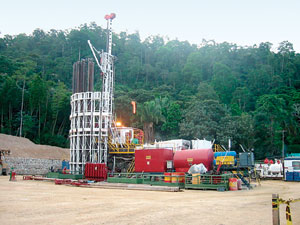 Technology from Europe: Technology from Europe:
Italy
Hydraulic rigs show improved performance
As of 2004, the Drilling Division of Soilmec has a new name, Drillmec, with its state-of-the-art technology and cost structure. The company will face the challenges of the wide open playing field of drilling and will cover its breadth and depth with new products/ solutions.
New concepts/advantages of HH series rigs. The HH series drilling rigs are designed, manufactured and tailored for oil fields where enhancement of a particular and relevant concept is the primary requirement for achieving high performance in terms of footage drilled, safely, and with environmental control.
Only an overall approach can give good results. If the final goal is a sound drilling cost and minimum environmental impact, along with a high safety level, the rig design should pay particular attention to:
- Fast moving and rig-up with reduced total number of loads
- Footprint reduction to reduce location dimension
- High level of rig automation and personnel reduction
- Noise reduction and minimum waste production
- Integration of services, i.e., cementing, casing running, data acquisition, etc.
The HH series rigs are hydraulic driven and have been used in a wide variety of field conditions – from the desert of North Africa to the freezing weather of Siberia – with results contributing added value to the projects.
 |
HH series hydraulic rigs operating in South America.
|
|
Main rig characteristics. A total hydraulic system drives all rig components in a self-contained configuration on truck or semi-trailer that is never disassembled for moving. The hydraulic system can be powered by diesel or electric unit, deck installed and contained in a sound-proof shelter.
The units have no drawworks, or massive mast structures with crown block and traveling equipment. Tripping of the drillstring and tubulars is done with a hydraulic cylinder which allows mast height reduction and lightening, making transportation easier. Only a light frame is necessary to support the reaction due to the top drive torque.
The top drive is hung from two cables that engage sheaves on the top of the cylinder and are fixed to the trailer frame. This configuration allows the hook to double the cylinder's speed. It allows, moreover, a pull-down controlled weight on bit up to 20 mt (44,150 lb) – particularly useful at shallow depths – and it avoids sudden jumping of the traveling assembly in overpull operations for stuck pipe.
Rig-up requires minimal time: The trailer reaches the proper height using hydraulic jacks, step-by-step up to 9-m (30-ft) elevation, and the mast is erected by another couple of jacks. The top drive and its cables are already in a working position; the mast is self-standing.
The vertical container system for drill pipes and drill collars, along with the jib crane fitted to the rig, make tubular transport during moving – as well as pipe connections and string running – easy and quick. Adequate containers are placed on the ground around the drill floor, each containing drill pipes from 2-3/8 in. up to 5 in., and drill collars up to 11-in. OD. Total storage capacity depends on size/ lengths of drill pipe. As a reference, total racking capacity may be 3,000 m (9,000 ft) with 3-1/2 -in., API Range 2 DP.
The handling system for the drillstring is completely automatic, without hand operations during tripping time, using a hydraulic vertical handling boom. A specific feature of the pipe handling in the rig is that drill pipe or casing is placed in a mouse hole and the top drive moves out from the well center, places itself over the mouse hole, takes the string element, lifts and carries it to the well center to add it to the drillstring.
For pipe connections, the top drive provides the necessary makeup torque. A dedicated device allows lifting and makeup of casing at controlled torque with values selected by the control panel.
A hydraulic device allows automatic drilling with a constant weight on bit (WOB) selected by the operator on the control panel. Alternatively, the rate of penetration can be set; in this case, the driller controls the WOB. In case of stuck pipe, controlled and predetermined values of overpull can be set.
Noise reduction is a topical issue, considering the frequent proximity of the drilling operation to villages and buildings. The rig does not have drilling brakes, which are the most difficult source of noise to eliminate. It is designed to avoid spillage from any portion of the equipment and it self-contains any fluid leakage as required.
Field results. Due to the rig characteristics, specific tools enabled the drilling service contractor of the Trevi Group, Petreven, to substantially reduce total drilling time, and lost time accidents (LTAs) with low environmental impact in drilling operations in Venezuelan and Colombian fields. Moving time has been substantially reduced. Tripping time has been improved and a tripping velocity of 1,500 ft/hr is an average standard registered with a crew of two persons.
Due to hydraulic control on the drilling parameter, high ROP performance has been registered, compared with a conventional rig also equipped with top drive. And casing installation has been faster.
Location dimensions have been reduced; a rig of 300 mt can be placed in a 38 x 22-m location. Noise level reduction has allowed drilling operations near cities or populated areas. And high safety records have been registered in the last 10 years of activity, without any LTAs. 
|

 Technology from Europe:
Technology from Europe:

